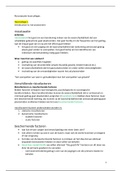1
Q&A’s
Poll question (lecture 5): SLR went down, but shouldn’t leverage increase if you borrow
more? Since banks borrowed more to buy treasuries.
Leverage increases if you borrow more is correct (other things being equal). But
Basel III defines the leverage ratio (SLR is the leverage ratio) as capital/assets, roughly. So,
if you borrow more, your assets go up (if you take a loan, you get debt on the liability side of
the balance sheet and cash on the asset side), but capital remains unchanged, hence the
leverage ratio goes down. i.e. high leverage = low leverage ratio, low leverage = high
leverage ratio in Basel III
Lecture 1 Bird’s eye view on financial markets and institutions
Flow of funds through the financial
system
main idea of financial system: channel
savings to the borrowers, transfer money
from those who have them to those who
need them
two ways:
- direct: savers bring dollars to the
security markets and the borrower
brings securities and then they
exchange dollars for securities
- indirect: ipv bringing dollars directly to security markets, you bring dollars to banks,
asset managers, pension funds. they bring the dollars to the security markets or
finance in other ways: loans, venture capital financing
Why do savers and borrowers need intermediaries?
1. Help us save transaction costs
Intermediaries take advantage of economies of scale. They also reduce search costs
2. Risk sharing
Intermediaries facilitate hedging against ‘bad’ states. Thus, they make markets ‘more
complete’
3. Information asymmetries: adverse selection and moral hazard
Information inefficiencies may lead to market breakdown. Financial intermediaries,
through pre-contractual (adverse selection)
research and post-contractual (moral
hazard) monitoring, reduce adverse
selection and moral hazard risks
How are financial intermediaries doing?
gross value added: corporate profits and wages
the share of gross value added in the financial
sector doubled
Financial markets
, 2
- Fixed income: massive market that determines the cost of money (and prices credit
risks)
- FX: determines the relative cost of money in different currency zones
- (Equity: determines how much shareholders’ equity is worth)
Financial institutions
- Depository institutions: commercial banks and other credit institutions
- Investment intermediaries: investment funds, investment banks, private banks, family
offices
- (Contractual savings institutions: insurance companies and pensions funds)
Both commercial banks and investment banks have a type of regulation influencing the
prices
Primary and secondary markets
- Primary markets: where debt or equity is raised (funds are borrowed).
Investment banks charge fees for organizing the issuance of securities. The desks in
charge are usually called ECM (equity capital markets) and DCM (debt capital
markets). It doesn’t need to be a public market. Markets for loans and private equity
financing are also primary markets with this regard.
- Secondary markets: where the value of existing (previously-issued) debt and equity
securities is determined by virtue of trading. This is a huge ecosystem: investors,
brokers and dealers, exchanges, trading platforms, clearing houses, rating agencies
etc.
Revenues generated by primary and secondary market services
Investment banking activities (M&A, ECM, DCM,
corporate lending) tend to trail secondary market
services in revenue generation among global
CIBs recently
Investment banking = primary
Global markets = secondary
equity underwriting = ECM
debt underwriting = DCM
secondary markets activities are the primary
resources of revenue of banks
debt securities creates more activity than equity
ones
Issuance of bonds and stocks
common trend
equity per year is about 600 billion
debt is about 18 trillion
debt has a magnitude of 30 times higher than
equity
but also take into account the fees per $ raised
that are different for ECM and DCM (higher)
services
, 3
In Europe, corporate loans are more
important than debt securities
US is more capital market centric
1.4 dollars of loan compared to 1 dollar of bonds
in the liabilities of American companies
equity financing in Europe is much less than in
the US, because public markets are much more
developed in the US
Mortgage was one of the main factors behind
long-term growth of finance
commercial: loans granted to corporates
real estate: mortgages, commercial property
loans
consumer: small consumer loans, credit card
debt
disproportionate growth of mortgages, fueled the
development of secondary markets
Securities markets by type
- Money markets: instruments with maturity < 1 year. Mainly fixed income and FX
- Capital markets: instruments with maturity > 1 year. Mainly equity and fixed income
Global stock markets capitalization and trading
volume
Europe is the third among Asia and US, cause here
they don't like public firms
major feature of stock market trading is the trading
volume
turnover = trading volume/market cap is quite high for
equity
Exchanges and over-the-counter markets
two ways how trading can be organized
- exchanges: equity's, equity derivatives, fixed
income futures, FX derivatives
- OTC: fixed income, fixed income derivatives, FX derivatives, equity derivatives
, 4
OTC >> exchanges
on exchange
- transaction costs are lower: trade
between buyer and seller almost
happens immediately
- information asymmetry is quite high:
trading is anonymous
on OTC
- transaction costs and search costs are
enormous, there is a chain of
intermediaries before the transaction
takes place
- information asymmetry: it's more a
relationship trading, brokers know exactly
who the clients are. there are ways to solve
information asymmetry, because there is
non-anonymity
Asset management: another driver behind the
growth of finance
major securities in the world are owned by asset
managers, they are holding portfolios of securities
massive growth of assets driving the growth of
finance
Lecture 2 Interest rates and fixed income markets
Global bond and equity markets (excl.
derivatives)
equity market is smaller
bond market is 20% bigger than equity market
Global OTC derivatives markets
OTC = bilateral agreement between two parties
without real standards as on an exchange
major type of derivatives are interest rate derivatives
Types of instruments
- Bonds
- Government and corporate, fixed and floating coupons, etc. - we tend to think
that government bonds are safe, there is very little risk that you are not paid
back. for corporate bonds there is credit risk, there is substantial probability
that the borrower defaults and you are not getting your money back
- Nonconvertible preferred stock
- Derivative Instruments
Q&A’s
Poll question (lecture 5): SLR went down, but shouldn’t leverage increase if you borrow
more? Since banks borrowed more to buy treasuries.
Leverage increases if you borrow more is correct (other things being equal). But
Basel III defines the leverage ratio (SLR is the leverage ratio) as capital/assets, roughly. So,
if you borrow more, your assets go up (if you take a loan, you get debt on the liability side of
the balance sheet and cash on the asset side), but capital remains unchanged, hence the
leverage ratio goes down. i.e. high leverage = low leverage ratio, low leverage = high
leverage ratio in Basel III
Lecture 1 Bird’s eye view on financial markets and institutions
Flow of funds through the financial
system
main idea of financial system: channel
savings to the borrowers, transfer money
from those who have them to those who
need them
two ways:
- direct: savers bring dollars to the
security markets and the borrower
brings securities and then they
exchange dollars for securities
- indirect: ipv bringing dollars directly to security markets, you bring dollars to banks,
asset managers, pension funds. they bring the dollars to the security markets or
finance in other ways: loans, venture capital financing
Why do savers and borrowers need intermediaries?
1. Help us save transaction costs
Intermediaries take advantage of economies of scale. They also reduce search costs
2. Risk sharing
Intermediaries facilitate hedging against ‘bad’ states. Thus, they make markets ‘more
complete’
3. Information asymmetries: adverse selection and moral hazard
Information inefficiencies may lead to market breakdown. Financial intermediaries,
through pre-contractual (adverse selection)
research and post-contractual (moral
hazard) monitoring, reduce adverse
selection and moral hazard risks
How are financial intermediaries doing?
gross value added: corporate profits and wages
the share of gross value added in the financial
sector doubled
Financial markets
, 2
- Fixed income: massive market that determines the cost of money (and prices credit
risks)
- FX: determines the relative cost of money in different currency zones
- (Equity: determines how much shareholders’ equity is worth)
Financial institutions
- Depository institutions: commercial banks and other credit institutions
- Investment intermediaries: investment funds, investment banks, private banks, family
offices
- (Contractual savings institutions: insurance companies and pensions funds)
Both commercial banks and investment banks have a type of regulation influencing the
prices
Primary and secondary markets
- Primary markets: where debt or equity is raised (funds are borrowed).
Investment banks charge fees for organizing the issuance of securities. The desks in
charge are usually called ECM (equity capital markets) and DCM (debt capital
markets). It doesn’t need to be a public market. Markets for loans and private equity
financing are also primary markets with this regard.
- Secondary markets: where the value of existing (previously-issued) debt and equity
securities is determined by virtue of trading. This is a huge ecosystem: investors,
brokers and dealers, exchanges, trading platforms, clearing houses, rating agencies
etc.
Revenues generated by primary and secondary market services
Investment banking activities (M&A, ECM, DCM,
corporate lending) tend to trail secondary market
services in revenue generation among global
CIBs recently
Investment banking = primary
Global markets = secondary
equity underwriting = ECM
debt underwriting = DCM
secondary markets activities are the primary
resources of revenue of banks
debt securities creates more activity than equity
ones
Issuance of bonds and stocks
common trend
equity per year is about 600 billion
debt is about 18 trillion
debt has a magnitude of 30 times higher than
equity
but also take into account the fees per $ raised
that are different for ECM and DCM (higher)
services
, 3
In Europe, corporate loans are more
important than debt securities
US is more capital market centric
1.4 dollars of loan compared to 1 dollar of bonds
in the liabilities of American companies
equity financing in Europe is much less than in
the US, because public markets are much more
developed in the US
Mortgage was one of the main factors behind
long-term growth of finance
commercial: loans granted to corporates
real estate: mortgages, commercial property
loans
consumer: small consumer loans, credit card
debt
disproportionate growth of mortgages, fueled the
development of secondary markets
Securities markets by type
- Money markets: instruments with maturity < 1 year. Mainly fixed income and FX
- Capital markets: instruments with maturity > 1 year. Mainly equity and fixed income
Global stock markets capitalization and trading
volume
Europe is the third among Asia and US, cause here
they don't like public firms
major feature of stock market trading is the trading
volume
turnover = trading volume/market cap is quite high for
equity
Exchanges and over-the-counter markets
two ways how trading can be organized
- exchanges: equity's, equity derivatives, fixed
income futures, FX derivatives
- OTC: fixed income, fixed income derivatives, FX derivatives, equity derivatives
, 4
OTC >> exchanges
on exchange
- transaction costs are lower: trade
between buyer and seller almost
happens immediately
- information asymmetry is quite high:
trading is anonymous
on OTC
- transaction costs and search costs are
enormous, there is a chain of
intermediaries before the transaction
takes place
- information asymmetry: it's more a
relationship trading, brokers know exactly
who the clients are. there are ways to solve
information asymmetry, because there is
non-anonymity
Asset management: another driver behind the
growth of finance
major securities in the world are owned by asset
managers, they are holding portfolios of securities
massive growth of assets driving the growth of
finance
Lecture 2 Interest rates and fixed income markets
Global bond and equity markets (excl.
derivatives)
equity market is smaller
bond market is 20% bigger than equity market
Global OTC derivatives markets
OTC = bilateral agreement between two parties
without real standards as on an exchange
major type of derivatives are interest rate derivatives
Types of instruments
- Bonds
- Government and corporate, fixed and floating coupons, etc. - we tend to think
that government bonds are safe, there is very little risk that you are not paid
back. for corporate bonds there is credit risk, there is substantial probability
that the borrower defaults and you are not getting your money back
- Nonconvertible preferred stock
- Derivative Instruments










